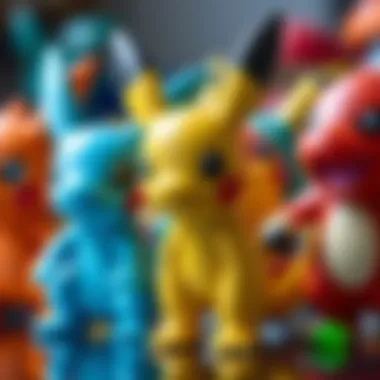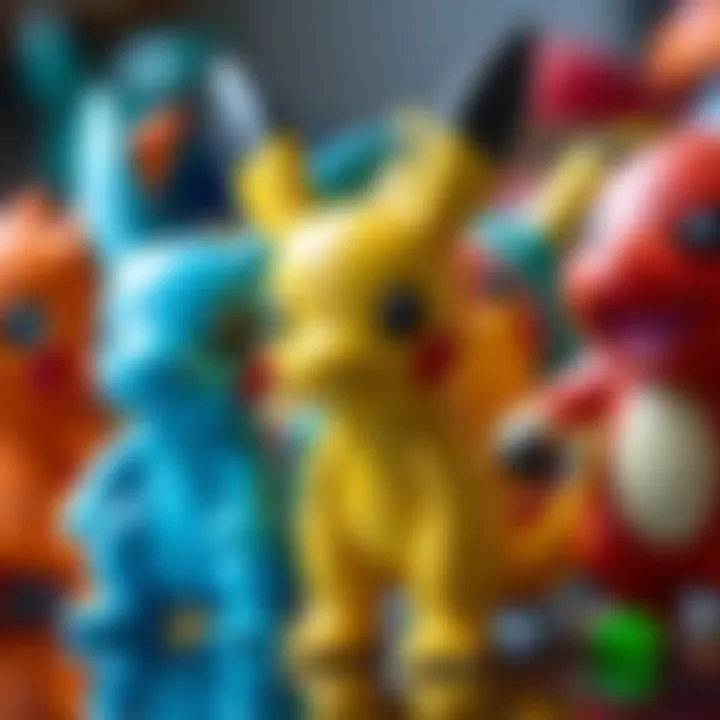Exploring the World of Pokémon Plastic Figures


Intro
As Pokémon continues to capture the hearts of fans around the globe, the plastic figures that depict these beloved creatures have also surged in popularity among collectors. These colorful figures are more than just toys; they encapsulate a rich history and a sense of nostalgia for many who grew up with the franchise. This article aims to provide an in-depth exploration of Pokémon plastic figures from a collector's perspective, delving into their cultural significance, production methods, and the vibrant community surrounding them.
The world of Pokémon figures is as diverse as the creature designs themselves. With different types available, from highly detailed collectible models to simpler toys aimed at younger audiences, the market dynamics are fascinating. The key to understanding this collector's paradise involves grasping the factors influencing their value, such as rarity and condition. This narrative will journey through the layers of this intriguing market, offering insights into trends and future projections.
"The joy of collecting Pokémon figures isn't just about the items themselves, but the stories and memories they bring back."
In exploring these themes, we will touch on several vital aspects, beginning with the production methods that create these figures, the evolution of their designs over time, and the distinctions that set them apart. Collectors often find themselves engrossed not just in acquiring figures, but also in the community they foster. Let's take a closer look at this captivating world, starting from the very fundamentals.
Intro to Pokémon Plastic Figures
When you think about collectibles, a certain charm envelopes the words "Pokémon plastic figures". These small replicas not only encapsulate the playful essence of Pokémon but also portray a rich tapestry of culture and fan engagement that intertwines with nostalgia. For collectors, these figures are more than mere toys; they serve as tangible artifacts of a world where imagination, artistry, and community collide. The focus of this section is to dig into why Pokémon plastic figures hold such significance in the realm of collectibles, buoyed by the shifting tides of history and pop culture.
Overview of the Pokémon Phenomenon
The Pokémon phenomenon transcends generations. It launched in the late 90s, sparking a wave of enthusiasm that caught on like wildfire across the globe. Kids and adults alike found themselves enchanted by the intricate designs and unique abilities of these fantastical creatures. The franchise opened the floodgates to merchandise, among which plastic figures hold a notable place. In essence, they are a celebration of the multi-dimensional universe created by Nintendo, Game Freak, and Creatures Inc.
In a nutshell, the Pokémon universe is not just about the animated series or video games; it’s a comprehensive ecosystem of storytelling and creative expression that fosters social connections. Many collectors recall their first figure as a pivotal moment, marking their initial foray into the world of Pokémon fandom. The figures often symbolize personal milestones—gifting, trading, or simply the pride in ownership can evoke a good sense of belonging. Additionally, they act as gateway pieces that start conversations in social gatherings and communities, leading to shared experiences and friendships.
Historical Context of Plastic Figures
The journey of Pokémon plastic figures closely mirrors the overall evolution of collectibles. Initially, when Pokémon first exploded onto the scene, the items available were largely simplistic—mass-produced, easily accessible, yet limited in release. Yet, as the years wore on, companies recognized the demand for more detailed and crafted figures. This prompted a visible shift in manufacturing technologies and artistic expression.
In the early 2000s, figures became more than just items to be played with; they turned into display pieces showcasing craftsmanship. The introduction of limited edition offerings added another layer of collectibility. Today, figures can be found in a myriad of forms, from highly articulated action figures to intricate statues, catering to both collectors and casual fans alike. The market now runs on speculation—what’s rare? What’s trending? This makes for a vibrant yet competitive collecting environment that mirrors the dynamics of the Pokémon battles themselves.
"Collecting Pokémon figures isn't just about gathering; it's about the stories, the shared experiences, and the artistry that each piece holds."
Collectors often find themselves enveloped in a narrative larger than the individual figures. Each piece roots collectors deeper into a storyline that invokes the dedication and nostalgia synonymous with Pokémon lore and culture. The continual growth of this aspect of the collecting realm indicates that Pokémon plastic figures are here to stay, continually evolving alongside the fandom they serve.
Types of Pokémon Plastic Figures
Understanding the assortment of Pokémon plastic figures is crucial for collectors and fans alike. Each type not only caters to varying tastes and budgets but also signifies a facet of the broader Pokémon culture. Different types of figures come with their unique characteristics, levels of detail, and appeal. The journey through this world reveals the intricate tapestry of collecting these iconic items, whether it's for nostalgia, art, or investment.
Action Figures
Action figures often give life to the Pokémon universe in a way that no other type can. These figures often come with movable limbs and accessories, mimicking the playful, adventurous essence of Pokémon battles. Generally, they are designed for interaction, allowing fans to recreate their favorite scenes from the games or shows.
From the vibrant colors of Pikachu to the detailed sculptures of Charizard, each action figure encapsulates its character's spirit, making them a staple in most collections. For many, it's not just about ownership but the thrill of storytelling that emerges when combining different figures in imaginative scenarios.
Benefits of Action Figures:
- Dynamic Playability: Their ability to move means collectors often use them in imaginative displays.
- Variety of Characters: Ranging from the iconic starters to legendary Pokémon, the selection is enormous.
- Customization Potential: Many collectors enjoy customizing these figures, using paint and materials to make each one unique.
Statues and Dioramas
On the opposite end of the spectrum, statues and dioramas offer a more fixed representation of Pokémon, often highlighting exquisite craftsmanship. These figures are generally made with a focus on aesthetics rather than playability, aimed at showcasing the beauty of character designs.
In a well-crafted diorama, one might find a scene from a Pokémon battle or a tranquil moment in the Pokémon world, complete with detailed backdrops and effects that truly visualize the Pokémon essence. These types of figures often have collectors feeling like they're owning a piece of art rather than merely a toy.
Considerations for Statues and Dioramas:
- Artistic Integrity: The level of detail can be stunning, making them perfect for display.
- Limited Mobility: Unlike action figures, movement is practically nil, positioning these figures more for sentimental value.
- Showcase Opportunities: Their striking visual appeal enhances any display case or shelf.


Gachapon Figures
For collectors who enjoy the thrill of surprise and delight, Gachapon figures represent an exciting corner of the Pokémon collection universe. Originating from Japanese vending machines, these encapsulated figures are small yet packed with character. Often collectable in sets, the randomness can bring about both joy and mild frustration, depending on how the luck of the draw plays out.
Key Features of Gachapon Figures:
- Affordability: Usually priced at a lower point, making them accessible for a wider audience.
- Collective Sets: The excitement of completing a set can be part of the fun.
- Unique Designs: Often feature characters in fun, unexpected poses, providing a charming take on the more traditional figures.
Limited Edition Releases
Limited edition releases in the Pokémon world can be akin to finding gold in a field. They often herald a special occasion or celebration, such as Pokémon anniversaries or major game launches. These figures usually come with distinctive designs or features, increasingly heightening their appeal among collectors.
Owning a limited edition figure not only boosts a collection’s value but also its prestige. Collectors often showcase these figures prominently, associating them with special memories or milestones in their Pokémon journey.
What Makes Limited Editions Special:
- High Rarity: Fewer figures often lead to increased market demand.
- Collector’s Pride: Owning something that few others have can be a source of pride.
- Investment Potential: Many see these figures as a good investment due to their potential for increasing value over time.
Collectively, exploring the different types of Pokémon plastic figures enriches the collector's experience. Whether one prefers the playability of action figures, the artistic flair of statues, the surprise element of Gachapon, or the desirability of limited editions, each type holds a special place in the evolving landscape of Pokémon memorabilia.
Production and Design of Figures
The production and design aspects of Pokémon plastic figures play a crucial role in shaping not just the physical collectibles but also the emotional attachment that fans develop towards them. From the initial concept to the final product gracing a collector's shelf, every phase of this process influences the overall quality, aesthetic appeal, and ultimately, the value of the figures. By understanding these elements, collectors can better appreciate the intricacies behind their beloved Pokémon plastic figures.
Manufacturing Processes
The journey of a Pokémon figure starts with the manufacturing processes that are employed to create it. These processes vary significantly depending on the type of figure being produced. For example, action figures often involve a combination of injection molding and assembly techniques, ensuring both rigidity and articulation. In contrast, statues may utilize rotocasting for a more seamless finish.
A typical manufacturing process might include the following steps:
- Conceptualization: Initial designs are made, focusing on the character’s features and proportions.
- Prototype Creation: A prototype is developed, allowing designers to assess the aesthetic and mechanical features.
- Mold Production: Once the prototype is approved, molds are crafted to enable mass production. This is a critical step as it determines the shape and detail of the final figures.
- Production Line: Figures are produced en masse based on the mold, undergoing quality control to assure minimal flaws in each item.
- Finishing Touches: Details such as painting and packaging are applied, making sure every piece meets the high expectations of collectors.
This multi-step process illustrates how simple plastic can transform into a well-loved figure, but it also emphasizes the importance of quality in manufacturing. Flaws in production can diminish a figure's value and appeal, highlighting the necessity of diligent craftsmanship in this collectible market.
Design Evolution
The design of Pokémon figures has undergone significant evolution since the franchise's inception. In the early days, figures were relatively simple and often lacked fine detail. However, as technology advanced, so did the approach to design. Early figures relied heavily on basic shapes and colors, but collectors can now enjoy intricate designs incorporating complex textures, realistic portrayals, and vivid colors.
Factors that have driven this evolution include:
- Advancements in Technology: The use of 3D modeling software and enhanced printing techniques has allowed for greater precision and intricacy in designs.
- Collector Feedback: Enthusiastic feedback from the community has pushed manufacturers to refine their designs to meet collectors' expectations.
- Competitive Trends: As more competitors enter the market, the demand for unique and artistically intricate pieces has risen. Manufacturers are continually adapting their design strategies to maintain a competitive edge.
This ongoing evolution ensures that collectors are not only investing in a figure but also a piece of art that captures the essence of the franchise.
Artistic Considerations
Designing Pokémon figures isn’t just about manufacturing; it’s also an art form that involves thoughtful consideration of various artistic elements. Manufacturers must balance aesthetic appeal with functionality, ensuring figures are eye-catching yet durable enough for handling.
Considerations include:
- Character Authenticity: Each figure needs to represent the specific Pokémon faithfully. Designers must understand the unique traits and personalities of the characters to truly capture their essence.
- Color Schemes: Effective use of color can significantly impact a figure’s appearance. Colors should reflect those found within the animated series or games, as this helps maintain authenticity.
- Pose and Expression: The pose of each figure should evoke emotion or action, offering a glimpse into the Pokémon’s character. Subtle details, like facial expressions and stances, can make a world of difference.
"Every Pokémon figure tells a story; it’s not just plastic, it's a representation of countless adventures and memories."
By paying attention to these artistic considerations, designers ensure that each figure resonates not just on a visual level but fosters a deeper connection tied to nostalgia and fandom. Collectors, therefore, find themselves not just acquiring pieces of plastic but valuable representations of their cherished franchise.


Overall, the production and design of Pokémon plastic figures encompass a fascinating interplay of technology, creativity, and craftsmanship. This intricate process not only enriches the collectibles market but also nurtures a deeper appreciation among fans and collectors who recognize the hard work that goes into each figure.
The Collectibility Factor
The world of Pokémon plastic figures is more than just colorful plastic molded into various forms. It's a vibrant tapestry woven with nostalgia, passion, and investment. Every collector knows that the factor of collectibility is a cornerstone of this hobby. It's not merely about possessing these figures but understanding the delicate interplay of rarity, condition, and market trends that dictate their value and relevance in the collector's realm.
Influence of Rarity
When it comes to collecting, rarity holds the golden key. The simple truth is that the fewer items there are of a particular type, the more sought after they become. For example, the first edition Charizard from the Pokémon Trading Card Game has achieved legendary status not just for its gameplay effectiveness but also because of how few were printed in its initial run.
Likewise, certain plastic figures, like limited edition or event-exclusive types, are prized possessions. Losing one to time or mishaps can turn an initially affordable figure into a grail item over the years. As the collector community grows, understanding the nuances of rarity becomes imperative.
- Limited Production Runs: Figures released as part of special events or holiday promotions often become collectors’ favorites. For instance, a Christmas Pikachu may see demand skyrocket as the holidays approach.
- Chase Figures: These are figures packed in with regular products but are harder to find. They're like the rare gem in the rough, and their scarcity makes them stand out even more in collections.
The allure of rarity underscores the passion within the Pokémon collector community, driving the excitement of hunting for that next elusive piece.
Condition and Preservation
You could have an incredibly rare Pokémon figure, but if it’s been left out in the sun to fade or still has the price sticker stuck to it, its value diminishes significantly. Maintaining the condition of these figures can be as tricky as hunting for them. For collectors, the condition can dictate whether a figure is worth a few dollars or a small fortune.
- ** mint Condition:** A figure from the box, untouched, still in its pristine state can fetch far more than one that's been poorly displayed or mishandled.
- Damages and Repairs: Chipped paint, scratches, or cracked bases might make a figure seem less appealing. Even repairs might reduce its market value, making it essential to handle these collectibles with care.
Some collectors invest in protective cases or display shelves that minimize dust and damage. Others might even go as far as using UV glass to protect from long-term sunlight exposure. After all, a little elbow grease goes a long way in ensuring a figure remains a treasure, rather than a relic of forgotten times.
Market Trends
Understanding the ups and downs of the market is crucial for anyone serious about collecting. It’s a bit like reading the tea leaves, but here are some trends worth noting:
- Online Communities: Platforms like Reddit and dedicated collector forums have changed the game for buying and selling. Real-time discussions about prices, trades, and collecting tips help keep enthusiasts informed.
- The Impact of Digital Collectibles: With the rise of NFTs and digital collectibles, there’s a growing conversation about how this could shape the physical collectible market. Will traditional figures fade into the background? Or will they hold their ground as tangible assets?
- Key Events and Releases: Major releases, like films or new game iterations, often drive up interest and demand for related figures. Keep an eye on upcoming trends.
Collecting is as much about passion as it is about economics; being plugged into the pulse of the market can make all the difference.
As Pokémon continues to evolve as a franchise, the landscape of its collectibles remains dynamic. Navigating this ever-changing realm is key to building a noteworthy collection that won't just cash in on nostalgia but also financial potential.
Community of Collectors
The community of collectors plays a pivotal role in the landscape of Pokémon plastic figures. It’s not just about grabbing these figures off the shelf; it's about connecting with others who share the same passion. Collecting can feel a bit lonely if one goes it alone, but communities can turn that solitary pursuit into a vibrant exchange of ideas, tips, and camaraderie. The joy of sharing collections, strategies for hunting down elusive figures, and discussions around market trends makes this community not just supportive, but essential.
Engaging with fellow collectors can set the stage for social interactions that often reach beyond the confines of collecting itself. Oftentimes, these interactions morph into friendships that grow stronger over years, tied together by shared enthusiasm for Pokémon lore and the figures that embody it. The exchange of stories about rare finds, whether from flea markets or online auctions, can feel like trading legendary Pokémon—each tale adds to the tapestry of the group’s shared history.
Additionally, community engagement has substantial benefits in terms of knowledge and resources. Newcomers can learn the ropes from seasoned collectors, gaining insights that might take years to glean through trial and error. This mentorship aspect fosters an environment where all can thrive, amplifying the experience of collecting many times over.
"A collection isn't just a storehouse of items; it’s a shared dream woven together by passion."
Online Communities and Forums
In today's digital age, online communities and forums serve as the backbone of the Pokémon plastic figure collector's ecosystem. Websites like Reddit, with its dedicated subreddits such as r/Pokemon, offer platofrms for discussions that cover everything from the latest releases to market values. Not only do these platforms provide a space for sharing photographs of collections, but they also facilitate vibrant discussions on various strategies for obtaining rare figures.
Many collectors also flock to platforms like Facebook to join specialized groups. These groups often contain thousands of members who post not just pictures of their collections but also engage in trades, sales, and various collectibles events. The power of social media has turned collecting into an interactive hobby where enthusiasts can share their opinions on new arrivals and even post tutorials on figure care. Discussion threads pull in perspectives that span the globe and chronicle the ever-evolving trends in Pokémon collecting.
Meetups and Conventions
Physical meetups and conventions are also a significant aspect of the collector community. Participating in events like Pokémon-centered conventions can be a real treat, for both seasoned collectors and newcomers alike. These gatherings provide not just rows of merchandise to browse, but face time with fellow enthusiasts. Collectors can trade, sell, and even display their prized possessions.
The excitement of networking with others who have the same passion is tangible in these settings. Discussions about collecting strategies, trends, and the latest figure releases often dominate the conversations. Moreover, attendees can attend panels where industry experts might shed light on upcoming products or share insights into future trends. Larger conventions even host contests, giving collectors a chance to showcase their collections on a grand stage.


Collaboration and Sharing
One of the most enriching aspects of being part of the Pokémon collector community is the spirit of collaboration and sharing. From organizing trading events to holding online contests for the best display of figures, these interactions contribute to a mutual sense of belonging among collectors.
Collectors often initiate projects where they can share their knowledge through blogs, podcasts, or video content. This not only enhances their own understanding but enriches the knowledge base of the community. Through these collaborative efforts, different collector perspectives can surface, encouraging variation in collecting styles and showcasing a diversity of tastes. Such interactions catalyze further engagement, driving a community that thrives on shared passion rather than mere competition.
The bond formed through collective experiences and knowledge-sharing fosters a culture that, at its core, prioritizes the joy of collecting rather than the relentless pursuit of profit.
Overall, the community of collectors serves not solely as a marketplace but as a living, breathing entity that thrives on shared experiences and collective enthusiasm for Pokémon plastic figures.
Future of Pokémon Plastic Figures
The future of Pokémon plastic figures stands at an intriguing crossroads, shaped by various factors that promise both challenges and exciting opportunities for collectors and enthusiasts alike. As the landscape of collectibles evolves, so does the approach toward production, design, and market dynamics of these figures. Collectors are not just interested in nostalgic pieces; they are also keen on trends that influence value, availability, and cultural significance. What unfolds in this section is an examination of emerging collecting trends, the surge of digital collectibles, and the growing imperative of sustainability in production practices.
Emerging Collecting Trends
In recent years, there has been a noticeable shift in how collectors engage with Pokémon figures. Gone are the days when nostalgia was the sole driving factor; today's collectors are young, tech-savvy, and are influenced by broader cultural and market dynamics. Here are some noteworthy trends:
- Diverse Collecting Niches: While traditional figures still hold appeal, new niches are emerging. Collectors are exploring variants such as oversized figures, plush versions, and unique artist interpretations, enabling a richer collecting experience.
- Customization: Customization has taken root within the community. Collectors take it upon themselves to modify existing figures, giving them a personal touch. This can involve painting, adding accessories, or altering poses, further enhancing the figure's uniqueness.
- Integration with Technology: Digital integration is gaining traction. Augmented reality applications connect the physical figures with digital enhancements, creating an interactive experience that is new and fascinating.
These trends signal a vibrant community that evolves alongside technological advancements, pushing the boundaries of what collectibles can be.
Market Impact of Digital Collectibles
The terrain of collectibles has shifted with the rise of digital collectibles, specifically in the Pokémon universe. Digital items have begun to carve out a market of their own. From trading cards on platforms like Pokémon TCG Online to digital artwork and NFTs, the implications are significant:
- Accessibility: Digital collectibles are often more accessible to a wider audience. Highly sought-after Pokémon, once tethered to physical items and exclusivity, can now reach global collectors without geographic barriers.
- Value Comparison: The juxtaposition of digital versus physical collectibles raises questions around value. As markets for both converge, understanding how each contributes to overall worth becomes essential.
- Community Engagement: New platforms create communities around digital collectibles. Websites such as Reddit host discussions where collectors can showcase their digital treasures, enabling a blend of camaraderie and commerce.
While there are skeptics, the increasing acceptance of digital collectibles suggests a blending of physical and digital worlds, opening avenues previously unheard of.
Sustainability in Production
As environmental consciousness rises, the production of Pokémon plastic figures faces scrutiny. Collectors increasingly demand that manufacturers uphold sustainable practices. This shift in mindset is important for several reasons:
- Consumer Demand: Modern collectors often consider the environmental footprint of products. Figures made from recycled or biodegradable materials are becoming attractive options, leading brands to reconsider their sourcing and production methods.
- Brand Reputation: Companies crafting figures need to align with a narrative of responsible production. Emphasizing eco-friendly initiatives can enhance brand loyalty among collectors who prioritize sustainability.
- Legislative Trends: Governments worldwide are enacting stricter regulations regarding plastic use and waste. Manufacturers must navigate these changes carefully, adapting to new mandates while maintaining quality and cost-effectiveness.
The drive towards sustainable practices is not merely a trend; it's a necessary evolution in the industry that shows promise for balancing quality, desirability, and environmental stewardship.
"Sustainability is no longer optional; it's essential for businesses to thrive in today’s market."
Through careful examination of these facets—emerging trends, the impact of digital collectibles, and sustainability—we can glean insights into the future trajectory of Pokémon plastic figures that promise thrilling developments ahead.
Finale
In wrapping up our deep dive into the realm of Pokémon plastic figures, it’s vital to acknowledge their significant footprint in the collecting landscape. These figures are not just toys; they represent a cultural phenomenon that transcends generations. From young fans of the Pokémon series to seasoned collectors who remember their childhood fondly, Pokémon figures have a special place in diverse hearts.
Summation of Observations
Throughout our exploration, we’ve uncovered several key observations:
- Cultural Impact: Pokémon plastic figures encapsulate the joy and wonder of a vast universe, allowing fans to possess tangible representations of their favorite characters. They serve as reminders of adventures in the Pokémon world, often triggering nostalgia for many collectors.
- Diverse Collections: The variety of figures ranges from detailed action figures to intricate dioramas; each type carries its own charm and value. Limited editions often command higher prices, making them coveted items in the collector's community.
- Collector Dynamics: Engagement in this collector’s scene fosters community. Conversations around rarity, condition, and preservation are common, creating a camaraderie among collectors. Online forums and conventions provide spaces where collectors can share their treasures, enhancing the experience of collecting.
- Market Trends: Analyzing the ever-shifting market for Pokémon figures reveals insights into what drives value and demand. Understanding market trends can further inform collectors about the future trajectories of their collections.
Reflections on Culture and Collectibility
The exploration of Pokémon plastic figures intertwines with broader themes in culture and collectibility. Figures echo the nostalgia associated with childhood experiences, fostering a connection that is both personal and social. Collectors often perceive their figures through the lenses of identity and community, forging bonds with fellow enthusiasts. As these figures populate shelves, they become more than mere objects; they transform into carriers of memory, conversation starters, and symbols of passion.
As the landscape continues to evolve, embracing technological advancements in digital collectibles may redefine the parameters of what it means to collect. Yet, despite these changes, the tactile nature of physical figures will likely retain its charm and allure for many collectors. The act of hunting down that elusive addition to a collection or the satisfaction derived from preserving a treasured piece embodies the spirit of collecting itself.
In essence, Pokémon plastic figures are cultural artifacts that reflect the changing tides of fandom and community. They embody memories, shared experiences, and the ongoing quest for the next big find in the vibrant world of collectibles.
Collecting is not merely an acquisition; it is a intimate dance between nostalgia and the allure of the unknown.



